Kent: Difference between revisions
mNo edit summary |
|||
| (6 intermediate revisions by 3 users not shown) | |||
| Line 6: | Line 6: | ||
|picture caption=Oast House in Tudeley | |picture caption=Oast House in Tudeley | ||
|motto=Invicta | |motto=Invicta | ||
|county town=[[Maidstone]] or [[Canterbury]] | |county town=[[Maidstone]] or [[Canterbury]] | ||
}} | }} | ||
The '''County of Kent''' is a [[Counties of the United Kingdom|shire]] at the south-eastern corner of [[Great Britain]]. The north-western towns of Kent are within | The '''County of Kent''' is a [[Counties of the United Kingdom|shire]] at the south-eastern corner of [[Great Britain]]. The north-western towns of Kent are within the [[London]] suburbs. Kent is considered is one of the [[home counties]]. | ||
Kent is known as "the Garden of England" for the richness of its agriculture, and the abundance of orchards and hop gardens. | Kent is known as "the Garden of England" for the richness of its agriculture, and the abundance of orchards and hop gardens. | ||
| Line 15: | Line 14: | ||
The name of Kent is the oldest recorded of any county, in its earliest form predating the coming of the Romans, and as the first kingdom established amongst the English after the Romans left Britain, Kent may claim to be Britain's oldest county. | The name of Kent is the oldest recorded of any county, in its earliest form predating the coming of the Romans, and as the first kingdom established amongst the English after the Romans left Britain, Kent may claim to be Britain's oldest county. | ||
Kent has dry borders with just two other shires; [[Sussex]] and [[Surrey]] to the west. Northward over the River Thames and its broad estuary lies [[Essex]], linked by one long road bridge and tunnel at [[Dartford]] and at the north-westernmost part of Kent it meets [[Middlesex]] across the Thames, a small meeting but enough to have a road tunnel carrying the | Kent has dry borders with just two other shires; [[Sussex]] and [[Surrey]] to the west. Northward over the River Thames and its broad estuary lies [[Essex]], linked by one long road bridge and tunnel at [[Dartford]] and at the north-westernmost part of Kent it meets [[Middlesex]] across the Thames, a small meeting but enough to have a [[Blackwall Tunnel|road tunnel]] carrying the A102 between them. Kent has a nominal border with France halfway through the [[Channel Tunnel]]. | ||
[[Maidstone]] is the [[county town]] and [[Canterbury]] its most ancient and famous city. Canterbury was once the capital of the Kingdom of Kent and remains the ecclesiastical capital of eastern Kent and of the whole Anglican Communion. [[Rochester]], the seat of the bishops over western Kent, | [[Maidstone]] is the [[county town]] and [[Canterbury]] its most ancient and famous city. Canterbury was once the capital of the Kingdom of Kent and remains the ecclesiastical capital of eastern Kent and of the whole Anglican Communion. [[Rochester]], the seat of the bishops over western Kent, is a second city, and one of the ''Medway Towns'' along with [[Strood]], [[Chatham]], [[Gillingham]], and [[Rainham, Kent|Rainham]]. | ||
Kent's location between [[London]] and Europe has led to its being in the front line of several conflicts, including the Battle of Britain during Second World War. East Kent was named ''Hell Fire Corner'' during the conflict. Britain has relied on the county's ports to provide warships through much of the past 800 years; the [[Cinque Ports]] in the 12th–14th centuries and [[Chatham]] Dockyard in the 16th–20th centuries were of particular importance to the country's security. France can be seen clearly in fine weather from [[Folkestone]], and the famous [[White Cliffs of Dover]]. | Kent's location between [[London]] and Europe has led to its being in the front line of several conflicts, including the Battle of Britain during Second World War. East Kent was named ''Hell Fire Corner'' during the conflict. Britain has relied on the county's ports to provide warships through much of the past 800 years; the [[Cinque Ports]] in the 12th–14th centuries and [[Chatham]] Dockyard in the 16th–20th centuries were of particular importance to the country's security. France can be seen clearly in fine weather from [[Folkestone]], and the famous [[White Cliffs of Dover]]. | ||
| Line 27: | Line 26: | ||
Kent is in the south-easternmost corner of Great Britain, surrounded on three sides by water; the [[River Thames]] and the [[North Sea]] to the north, and the [[Straits of Dover]] and the [[English Channel]] to the east and south. France lies 21 miles across the Strait. | Kent is in the south-easternmost corner of Great Britain, surrounded on three sides by water; the [[River Thames]] and the [[North Sea]] to the north, and the [[Straits of Dover]] and the [[English Channel]] to the east and south. France lies 21 miles across the Strait. | ||
The major geographical features of | The major geographical features of Kent are determined by a series of ridges and valleys running east-west across the county. These are the results of erosion of the Wealden dome, a dome across Kent and [[Sussex]] created by Alpine movements 10–20 million years ago. This dome consists of an upper layer of chalk above successive layers of upper greensand, gault clay, lower greensand, Weald clay, and Wealden sandstone. The ridges and valleys formed when the exposed clay eroded faster than the exposed chalk, greensand, or sandstone. | ||
[[Sevenoaks]], [[Maidstone]], [[Ashford, Kent|Ashford]], and [[Folkestone]] are built on greensand,<ref name="gswik"/> while [[Tonbridge]] and [[Tunbridge Wells]] are built on sandstone.<ref name="stamp"/> [[Dartford]], [[Gravesend, Kent|Gravesend]], the Medway towns, [[Sittingbourne]], [[Faversham]], [[Canterbury]], [[Deal]], and [[Dover]] are built on chalk.<ref name="gswik">{{cite book | title=Greensand Way in Kent | publisher=Kent Council | year=1992|isbn=1-873010-23-0}}</ref><ref name="stamp">Britain's Structure and Scenery, L Dudley Stamp, Pub September 1946, Collins New Naturalist Series.</ref> The easterly section of the Wealden dome has been eroded away by the sea, and cliffs such as the white cliffs of Dover are present where a chalk ridge of the [[North Downs]] meets the coast. Spanning Dover and [[Westerham]] is the Kent Downs Area of Outstanding Natural Beauty.<ref name="downs">{{cite web | title=Kent Downs | publisher=KentDowns.org | url=http://www.kentdowns.org.uk/ | accessdate=20 April 2007 }}</ref> | |||
[[Sevenoaks]], [[Maidstone]], [[Ashford, Kent|Ashford]], and [[Folkestone]] are built on greensand,<ref name="gswik"/> while [[Tonbridge]] and [[Tunbridge Wells]] are built on sandstone.<ref name="stamp"/> [[Dartford]], [[Gravesend, Kent|Gravesend]], the Medway towns, [[Sittingbourne]], [[Faversham]], [[Canterbury]], [[Deal]], and [[Dover]] are built on chalk.<ref name="gswik">{{cite book | title=Greensand Way in Kent | publisher=Kent | |||
The Wealden dome is a Mesozoic structure lying on a Palaeozoic foundation, which can often create the right conditions for coal formation and indeed coal is found in eastern Kent roughly between Deal, Canterbury, and Dover. The Coal Measures within the Westphalian Sandstone are deep about 800 – 1300 feet and subject to flooding. They occur in two major troughs, which extend under the English Channel where similar coalfields are located.<ref name="gkb">{{cite web | title=Geology of Kent and Boulonnais | publisher=The Geology Shop | url=http://www.geologyshop.co.uk/geolkb.htm | year=2000 | accessdate= | The Wealden dome is a Mesozoic structure lying on a Palaeozoic foundation, which can often create the right conditions for coal formation and indeed coal is found in eastern Kent roughly between Deal, Canterbury, and Dover. The Coal Measures within the Westphalian Sandstone are deep about 800 – 1300 feet and subject to flooding. They occur in two major troughs, which extend under the English Channel where similar coalfields are located.<ref name="gkb">{{cite web | title=Geology of Kent and Boulonnais | publisher=The Geology Shop | url=http://www.geologyshop.co.uk/geolkb.htm | year=2000 | accessdate=8 August 2009 }}</ref> | ||
Seismic activity has occasionally been recorded in Kent, though the epicentres were offshore. In 1382 and 1580 there were two earthquakes the descriptions of which suggest that they exceeded 6.0 on the Richter Scale. In 1776, 1950, and on 28 April 2007 there were earthquakes of around 4.3. The 2007 earthquake caused physical damage in Folkestone.<ref name="gquake">{{cite news | title=Quake causes Kent Families to flee Homes | publisher=The Guardian | url=http://observer.guardian.co.uk/uk_news/story/0,,2068090,00.html | date=29 April 2007 | accessdate=28 April 2007 | location=London | first=Amelia | last=Hill}}</ref> | Seismic activity has occasionally been recorded in Kent, though the epicentres were offshore. In 1382 and 1580 there were two earthquakes the descriptions of which suggest that they exceeded 6.0 on the Richter Scale. In 1776, 1950, and on 28 April 2007 there were earthquakes of around 4.3. The 2007 earthquake caused physical damage in Folkestone.<ref name="gquake">{{cite news | title=Quake causes Kent Families to flee Homes | publisher=The Guardian | url=http://observer.guardian.co.uk/uk_news/story/0,,2068090,00.html | date=29 April 2007 | accessdate=28 April 2007 | location=London | first=Amelia | last=Hill}}</ref> | ||
| Line 41: | Line 39: | ||
Kent's principal river, the [[River Medway]], rises near [[East Grinstead]] in [[Sussex]] and flows eastwards to [[Maidstone]]. Here it turns north and breaks through the North Downs at Rochester, then joins the estuary of the River Thames as its final tributary near [[Sheerness]]. The Medway is some 70 miles long.<ref name="medway"/><ref>[http://www.environment-agency.gov.uk/homeandleisure/recreation/boating/31577.aspx Environmental Agency: River Medway]</ref> The river is tidal as far as [[Allington, Kent|Allington]] lock, but in earlier times, cargo-carrying vessels reached as far upstream as [[Tonbridge]].<ref name="medway">{{cite book | last=Bowskill|first=Derek | title=Map Of The River Medway }}</ref> The Medway has captured the head waters of other rivers such as the [[River Darent]]. Other rivers of Kent include the [[River Stour, Kent|River Stour]] in the east. | Kent's principal river, the [[River Medway]], rises near [[East Grinstead]] in [[Sussex]] and flows eastwards to [[Maidstone]]. Here it turns north and breaks through the North Downs at Rochester, then joins the estuary of the River Thames as its final tributary near [[Sheerness]]. The Medway is some 70 miles long.<ref name="medway"/><ref>[http://www.environment-agency.gov.uk/homeandleisure/recreation/boating/31577.aspx Environmental Agency: River Medway]</ref> The river is tidal as far as [[Allington, Kent|Allington]] lock, but in earlier times, cargo-carrying vessels reached as far upstream as [[Tonbridge]].<ref name="medway">{{cite book | last=Bowskill|first=Derek | title=Map Of The River Medway }}</ref> The Medway has captured the head waters of other rivers such as the [[River Darent]]. Other rivers of Kent include the [[River Stour, Kent|River Stour]] in the east. | ||
==The Cinque Ports== | ==The Lathes of Kent== | ||
Kent is divided into ''[[Lathes of Kent|Lathes]]'', which are divisions unique to the county. ({{kmloutline|Lathes of Kent}}) Each lathe comprises a group of hundreds. The lathes are: | |||
*[[Lathe of Saint Augustine]] - easternmost of the lathes, Saint Augustine's includes [[Canterbury]] and the seaside towns from [[Whitstable]] to [[Dover]]. | |||
*[[Lathe of Shepway]] - southernmost and least populous of the lathes, Shepway encompasses the seaside towns from the Sussex border to [[Folkestone]]. | |||
*[[Lathe of Scray]] - one of the two central lathes, Scray stretches from the [[Isle of Sheppey]] to the Sussex border at [[Hawkhurst]]. | |||
*[[Lathe of Aylesford]] - the other central lathe, Aylesford incorporates the land from the Medway towns around [[Rochester]] to [[Tunbridge Wells]]. | |||
*[[Lathe of Sutton-at-Hone]] - northernmost and most populous of the lathes, Sutton-at-Hone comprises the metropolitan suburbs of Kent. | |||
==Towns and villages== | |||
The towns of Kent range from traditional seaside resorts such as [[Folkestone]] and [[Margate]] on the south coast, through new towns such as the Ebbsfleet Valley in northern Kent, to the London suburbs of [[Deptford]], [[Greenwich]] and [[Woolwich]]. Throughout there are many traditional rural villages. | |||
===Cities=== | |||
*[[Canterbury]] | |||
*[[Rochester]] | |||
===Towns=== | |||
{{div col|3}} | |||
*[[Ashford, Kent|Ashford]] | |||
*[[Bexleyheath]] | |||
*[[Biggin Hill]] | |||
*[[Broadstairs]] | |||
*[[Bromley]] | |||
*[[Catford]] | |||
*[[Chatham]] | |||
*[[Cranbrook]] | |||
*[[Dartford]] | |||
*[[Deptford]] | |||
*[[Deal]] | |||
*[[Dover]] | |||
*[[Edenbridge]] | |||
*[[Eltham]] | |||
*[[Faversham]] | |||
*[[Folkestone]] | |||
*[[Gillingham]] | |||
*[[Greenwich]] | |||
*[[Herne Bay]] | |||
*[[Hythe]] | |||
*[[Lydd]] | |||
*[[Maidstone]] ''([[county town]])'' | |||
*[[Margate]] | |||
*[[New Romney]] | |||
*[[Northfleet]] | |||
*[[Orpington]] | |||
*[[Paddock Wood]] | |||
*[[Ramsgate]] | |||
*[[Royal Tunbridge Wells]] ''(partly in [[Sussex]])'' | |||
*[[Sandwich]] | |||
*[[Sheerness]] | |||
*[[Sittingbourne]] | |||
*[[Snodland]] | |||
*[[Strood]] | |||
*[[Swanley]] | |||
*[[Tenterden]] | |||
*[[Tonbridge]] | |||
*[[West Malling]] | |||
*[[Westerham]] | |||
*[[Whitstable]] | |||
*[[Woolwich]] | |||
{{div col end}} | |||
===The Cinque Ports=== | |||
{{Main|Cinque Ports}} | {{Main|Cinque Ports}} | ||
[[File:Cinque Ports map.svg|right|thumb|220px|Map of the Cinque Ports and their "limbs"]] | [[File:Cinque Ports map.svg|right|thumb|220px|Map of the Cinque Ports and their "limbs"]] | ||
The '''Cinque Ports''' are a historic confederation of coastal towns most of which are in | The '''Cinque Ports''' are a historic confederation of coastal towns most of which are in Kent, with other members in [[Sussex]]. The confederation was originally formed for military and trade purposes, commanding the narrow seas, and the ports were required to supply 57 ships, each with a crew of 21 men and a boy, for 15 days every year in return for which, the Ports were granted privileges, powers and exemption from certain taxes. Now the Cinque Ports are entirely ceremonial and all apart from Dover have silted up. | ||
A remaining jurisdiction is the Court of Admiralty of the Cinque Ports whose jurisdiction covers much of the North Sea, the English Channel and the Straits of Dover; the world's busiest shipping lanes. However, the Court has not sat for many years. | A remaining jurisdiction is the Court of Admiralty of the Cinque Ports whose jurisdiction covers much of the North Sea, the English Channel and the Straits of Dover; the world's busiest shipping lanes. However, the Court has not sat for many years. | ||
| Line 87: | Line 145: | ||
The Royal Navy first used the [[River Medway]] in 1547. By the reign of Elizabeth I (1558–1603) a small dockyard had been established at [[Chatham]]. By 1618, storehouses, a ropewalk, a drydock, and houses for officials had been built downstream from Chatham.<ref name=THDC>{{cite book | title=The Historic Dockyard Chatham — where legends were created | publisher=Jarrold Publishing |year=2005 }}</ref> | The Royal Navy first used the [[River Medway]] in 1547. By the reign of Elizabeth I (1558–1603) a small dockyard had been established at [[Chatham]]. By 1618, storehouses, a ropewalk, a drydock, and houses for officials had been built downstream from Chatham.<ref name=THDC>{{cite book | title=The Historic Dockyard Chatham — where legends were created | publisher=Jarrold Publishing |year=2005 }}</ref> | ||
The naval dockyards dominated [[Deptford]] in north-eastern Kent for centuries; The King's Yard was established in 1513 by Henry VIII as the first Royal Dockyard building vessels for the Royal Navy, and it continued as a major | The naval dockyards dominated [[Deptford]] in north-eastern Kent for centuries; The King's Yard was established in 1513 by Henry VIII as the first Royal Dockyard building vessels for the Royal Navy, and it continued as a major shipbuilding yard until the nineteenth century, by which time it had been surpassed by yards able to build the bigger ships of the day. Many of the events of history took place at Deptford; here Francis Drake was knighted aboard the Golden Hind, from here sailed expeditions by Captain James Cook, Frobisher and Vancouver, and fleets bound for battle. It was to this Kentish dockyard that Tsar Peter the Great came in 1698 to learn about shipbuilding and seamanship. | ||
In 1694 the Royal Hospital for Seamen at Greenwich opened and remained until 1869. When the Greenwich Hospital was closed it was converted to a training establishment of the Royal Navy: The Royal Naval College was established in Greenwich in Kent from 1873 to 1998 when the College closed. | In 1694 the Royal Hospital for Seamen at Greenwich opened and remained until 1869. When the Greenwich Hospital was closed it was converted to a training establishment of the Royal Navy: The Royal Naval College was established in Greenwich in Kent from 1873 to 1998 when the College closed. | ||
| Line 118: | Line 176: | ||
The county’s motto is ''Invicta'' (“unconquered”). Legend has it that this motto comes from the days of William the Conqueror: while William had taken London or was on his way there, he passed through Kent. The local people gathered an army and advanced against him. | The county’s motto is ''Invicta'' (“unconquered”). Legend has it that this motto comes from the days of William the Conqueror: while William had taken London or was on his way there, he passed through Kent. The local people gathered an army and advanced against him. | ||
One version has it that the men with branches in their hands drove William and his army to flight so that they took a different route to London. A different version of the legend is depicted on a monument at [[Swanscombe]], where legend states this meeting took place on the Old Roman Road to London (Watling Street). The Monument (moved in the early 1960s due to the construction of the A2 Dual Carriageway) is now located in the church yard of Saint Peter and Saint Paul's | One version has it that the men with branches in their hands drove William and his army to flight so that they took a different route to London. A different version of the legend is depicted on a monument at [[Swanscombe]], where legend states this meeting took place on the Old Roman Road to London (Watling Street). The Monument (moved in the early 1960s due to the construction of the A2 Dual Carriageway) is now located in the church yard of Saint Peter and Saint Paul's Church in Swanscombe, and it states: | ||
<blockquote>Near this spot by ancient tradition The Men of Kent and Kentish Men Carrying Boughs on their shoulders and swords in their hands met the invader William Duke of Normandy. They offered peace if He would grant their Ancient Rights and Liberties otherwise War and that Most Deadly. Their Request was granted and from that day the motto of Kent has been INVICTA meaning Unconquered."</blockquote> | <blockquote>Near this spot by ancient tradition The Men of Kent and Kentish Men Carrying Boughs on their shoulders and swords in their hands met the invader William Duke of Normandy. They offered peace if He would grant their Ancient Rights and Liberties otherwise War and that Most Deadly. Their Request was granted and from that day the motto of Kent has been INVICTA meaning Unconquered."</blockquote> | ||
Thus according to the legend, William conquered England but | Thus according to the legend, William conquered England but not Kent, which undefeated made a separate peace with him. | ||
==Arts== | ==Arts== | ||
Latest revision as of 14:18, 16 March 2024
| Kent United Kingdom | |
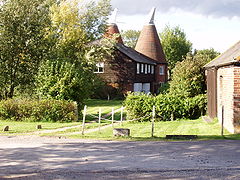 Oast House in Tudeley | |
|---|---|

| |
| Flag | |
| Invicta | |
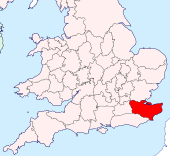
| |
| [Interactive map] | |
| Area: | 1,611 square miles |
| Population: | 2,747,715 |
| County town: | Maidstone or Canterbury |
| County flower: | Hop [1] |
The County of Kent is a shire at the south-eastern corner of Great Britain. The north-western towns of Kent are within the London suburbs. Kent is considered is one of the home counties.
Kent is known as "the Garden of England" for the richness of its agriculture, and the abundance of orchards and hop gardens.
The name of Kent is the oldest recorded of any county, in its earliest form predating the coming of the Romans, and as the first kingdom established amongst the English after the Romans left Britain, Kent may claim to be Britain's oldest county.
Kent has dry borders with just two other shires; Sussex and Surrey to the west. Northward over the River Thames and its broad estuary lies Essex, linked by one long road bridge and tunnel at Dartford and at the north-westernmost part of Kent it meets Middlesex across the Thames, a small meeting but enough to have a road tunnel carrying the A102 between them. Kent has a nominal border with France halfway through the Channel Tunnel.
Maidstone is the county town and Canterbury its most ancient and famous city. Canterbury was once the capital of the Kingdom of Kent and remains the ecclesiastical capital of eastern Kent and of the whole Anglican Communion. Rochester, the seat of the bishops over western Kent, is a second city, and one of the Medway Towns along with Strood, Chatham, Gillingham, and Rainham.
Kent's location between London and Europe has led to its being in the front line of several conflicts, including the Battle of Britain during Second World War. East Kent was named Hell Fire Corner during the conflict. Britain has relied on the county's ports to provide warships through much of the past 800 years; the Cinque Ports in the 12th–14th centuries and Chatham Dockyard in the 16th–20th centuries were of particular importance to the country's security. France can be seen clearly in fine weather from Folkestone, and the famous White Cliffs of Dover.
Major industries in the north-west of Kent have included cement, papermaking, and aircraft construction, but these are now in decline. Large parts of Kent are within the London commuter belt. Southern and eastern Kent rely on tourism and agriculture. Coal mining has also played its part in Kent's industrial heritage.
Geography
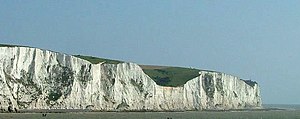
Kent is in the south-easternmost corner of Great Britain, surrounded on three sides by water; the River Thames and the North Sea to the north, and the Straits of Dover and the English Channel to the east and south. France lies 21 miles across the Strait.
The major geographical features of Kent are determined by a series of ridges and valleys running east-west across the county. These are the results of erosion of the Wealden dome, a dome across Kent and Sussex created by Alpine movements 10–20 million years ago. This dome consists of an upper layer of chalk above successive layers of upper greensand, gault clay, lower greensand, Weald clay, and Wealden sandstone. The ridges and valleys formed when the exposed clay eroded faster than the exposed chalk, greensand, or sandstone.
Sevenoaks, Maidstone, Ashford, and Folkestone are built on greensand,[1] while Tonbridge and Tunbridge Wells are built on sandstone.[2] Dartford, Gravesend, the Medway towns, Sittingbourne, Faversham, Canterbury, Deal, and Dover are built on chalk.[1][2] The easterly section of the Wealden dome has been eroded away by the sea, and cliffs such as the white cliffs of Dover are present where a chalk ridge of the North Downs meets the coast. Spanning Dover and Westerham is the Kent Downs Area of Outstanding Natural Beauty.[3]
The Wealden dome is a Mesozoic structure lying on a Palaeozoic foundation, which can often create the right conditions for coal formation and indeed coal is found in eastern Kent roughly between Deal, Canterbury, and Dover. The Coal Measures within the Westphalian Sandstone are deep about 800 – 1300 feet and subject to flooding. They occur in two major troughs, which extend under the English Channel where similar coalfields are located.[4]
Seismic activity has occasionally been recorded in Kent, though the epicentres were offshore. In 1382 and 1580 there were two earthquakes the descriptions of which suggest that they exceeded 6.0 on the Richter Scale. In 1776, 1950, and on 28 April 2007 there were earthquakes of around 4.3. The 2007 earthquake caused physical damage in Folkestone.[5]
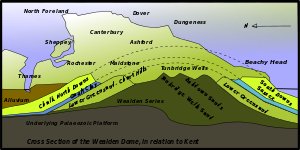
The coastline of Kent is continuously changing, due to tectonic uplift and coastal erosion. Until about 960, the Isle of Thanet was an island, separated by the Wantsum channel, formed around a deposit of chalk; over time, the channels silted up with alluvium. Similarly Romney Marsh and Dungeness have been formed by accumulation of alluvium.[2]
Kent's principal river, the River Medway, rises near East Grinstead in Sussex and flows eastwards to Maidstone. Here it turns north and breaks through the North Downs at Rochester, then joins the estuary of the River Thames as its final tributary near Sheerness. The Medway is some 70 miles long.[6][7] The river is tidal as far as Allington lock, but in earlier times, cargo-carrying vessels reached as far upstream as Tonbridge.[6] The Medway has captured the head waters of other rivers such as the River Darent. Other rivers of Kent include the River Stour in the east.
The Lathes of Kent
Kent is divided into Lathes, which are divisions unique to the county. (map) Each lathe comprises a group of hundreds. The lathes are:
- Lathe of Saint Augustine - easternmost of the lathes, Saint Augustine's includes Canterbury and the seaside towns from Whitstable to Dover.
- Lathe of Shepway - southernmost and least populous of the lathes, Shepway encompasses the seaside towns from the Sussex border to Folkestone.
- Lathe of Scray - one of the two central lathes, Scray stretches from the Isle of Sheppey to the Sussex border at Hawkhurst.
- Lathe of Aylesford - the other central lathe, Aylesford incorporates the land from the Medway towns around Rochester to Tunbridge Wells.
- Lathe of Sutton-at-Hone - northernmost and most populous of the lathes, Sutton-at-Hone comprises the metropolitan suburbs of Kent.
Towns and villages
The towns of Kent range from traditional seaside resorts such as Folkestone and Margate on the south coast, through new towns such as the Ebbsfleet Valley in northern Kent, to the London suburbs of Deptford, Greenwich and Woolwich. Throughout there are many traditional rural villages.
Cities
Towns
- Ashford
- Bexleyheath
- Biggin Hill
- Broadstairs
- Bromley
- Catford
- Chatham
- Cranbrook
- Dartford
- Deptford
- Deal
- Dover
- Edenbridge
- Eltham
- Faversham
- Folkestone
- Gillingham
- Greenwich
- Herne Bay
- Hythe
- Lydd
- Maidstone (county town)
- Margate
- New Romney
- Northfleet
- Orpington
- Paddock Wood
- Ramsgate
- Royal Tunbridge Wells (partly in Sussex)
- Sandwich
- Sheerness
- Sittingbourne
- Snodland
- Strood
- Swanley
- Tenterden
- Tonbridge
- West Malling
- Westerham
- Whitstable
- Woolwich
The Cinque Ports
- Main article: Cinque Ports
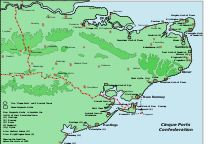
The Cinque Ports are a historic confederation of coastal towns most of which are in Kent, with other members in Sussex. The confederation was originally formed for military and trade purposes, commanding the narrow seas, and the ports were required to supply 57 ships, each with a crew of 21 men and a boy, for 15 days every year in return for which, the Ports were granted privileges, powers and exemption from certain taxes. Now the Cinque Ports are entirely ceremonial and all apart from Dover have silted up.
A remaining jurisdiction is the Court of Admiralty of the Cinque Ports whose jurisdiction covers much of the North Sea, the English Channel and the Straits of Dover; the world's busiest shipping lanes. However, the Court has not sat for many years.
The name originates in Norman French, meaning "five ports", and its members are:
- Original members:
- Two Antient Towns:
In addition, seven towns are Limbs of members, namely:
- limbs of Dover: Folkestone, Faversham and Margate
- limb of New Romney: Lydd
- Limb of Rye: Tenterden
- Limb of Sandwichs Deal, Ramsgate
History
Early history
Kent has been occupied since the Palaeolithic era, as attested by finds from the quarries at Swanscombe. The Medway megaliths were built during the Neolithic era. There is a rich sequence of Bronze Age, Iron Age, and Roman era occupation, as indicated by finds and features such as the Ringlemere gold cup and the Roman villas of the Darent valley.[8]
The modern name of Kent is derived from an Ancient British word or perhaps an earlier name. It may be from a word Cantus meaning "rim" or "border" or a Proto-Celtic *kanto- meaning "white", referring to the chalky soil of the region and/or the White Cliffs of Dover. Julius Caesar had described the area as Cantium, or home of the Cantiaci in 51 BC.[9]
The extreme west of the modern county was occupied by Iron Age tribes, known as the Regnenses. It is possible that another tribe occupied what is now called The Weald and East Kent. East Kent became a kingdom of the Jutes during the 5th century[10] and was known in Old English as Cent or Centlond. The early mediæval inhabitants of the county were known as the Cantwara, or Kent people, and their capital was Catwaraburg; Canterbury.
Middle Ages
In 597, Augustine arrived in Kent, appointed as a bishop and missionary to the English. He successfully converted the heathen King Æthelberht of Kent to Christianity, then established the Diocese of Canterbury and became the first Archbishop of Canterbury. Canterbury remains the centre of the Church of England and of the wider Anglican Communion.
In 1066 the Normans landed nearby in Sussex. The men of Kent according to legend raised the fyrd to oppose him independently and made a separate peace without clash of arms. This legend is the origin of the county motto Invicta, meaning "unconquered".
During the mediæval and early modern period, Kent played a major role in several of England's most notable rebellions, including the Peasants' Revolt of 1381, led by Wat Tyler,[11] Jack Cade's Kent rebellion of 1450, and Wyatt's Rebellion of 1554 against Queen Mary I.[12]
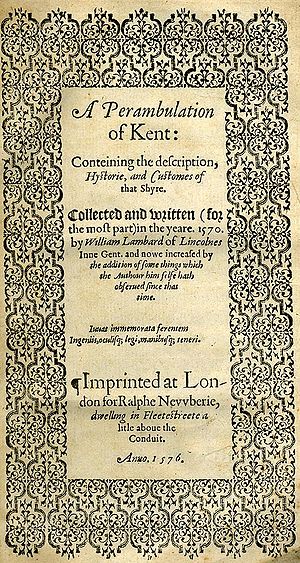

The Royal Navy first used the River Medway in 1547. By the reign of Elizabeth I (1558–1603) a small dockyard had been established at Chatham. By 1618, storehouses, a ropewalk, a drydock, and houses for officials had been built downstream from Chatham.[13]
The naval dockyards dominated Deptford in north-eastern Kent for centuries; The King's Yard was established in 1513 by Henry VIII as the first Royal Dockyard building vessels for the Royal Navy, and it continued as a major shipbuilding yard until the nineteenth century, by which time it had been surpassed by yards able to build the bigger ships of the day. Many of the events of history took place at Deptford; here Francis Drake was knighted aboard the Golden Hind, from here sailed expeditions by Captain James Cook, Frobisher and Vancouver, and fleets bound for battle. It was to this Kentish dockyard that Tsar Peter the Great came in 1698 to learn about shipbuilding and seamanship.
In 1694 the Royal Hospital for Seamen at Greenwich opened and remained until 1869. When the Greenwich Hospital was closed it was converted to a training establishment of the Royal Navy: The Royal Naval College was established in Greenwich in Kent from 1873 to 1998 when the College closed.
By the 17th century, tensions between Britain and the powers of the Netherlands and France led to increasing military build-up in the county. Forts were built all along the coast following the raid on the Medway, a successful attack by the Dutch navy on the shipyards of the Medway towns in 1667.[14]
The 18th century was dominated by wars with France, during which the Medway became the primary base for a fleet that could act along the Dutch and French coasts. When the theatre of operation moved to the Atlantic, this role was assumed by Portsmouth and Plymouth, with Chatham concentrating on shipbuilding and ship repair. The first Ordnance Survey map ever drawn was a one-inch map of Kent, published in 1801.[15]
Urbanisation
The nineteenth century was a time of growth. The railways came to Kent and where the rails stretched out from London, towns strung up and grew beside them. Many of the Kentish towns close to London grew to form part of the metropolitan conurbation, and this process continued with yet more vigour in the twentieth century, so that the whole of the north-west of the county became part of the conurbation, the towns all running into one another, with just a few green spaces to make the gaps even as far as Bromley.
During Second World War, much of the Battle of Britain was fought in the skies over the county. Between June 1944 and March 1945, over 10,000 V1 flying bombs, known as "Doodlebugs", were launched at London from bases in Northern France. Many were destroyed by aircraft, anti-aircraft guns, and barrage balloons, yet London and Kent were hit by around 2,500 of these bombs.
Culture
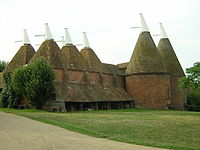
Kent is the "Garden of England", famed for its rich arable farmland.
Kent is famed in particular for hops, grown for brewing. Each harvest time until some time after the war, when automation took hold, trainloads of young men and women used to pour into the Kentish countryside from Kent, from London and beyond to pick the hops, camping out in the fields for the week. Oast Houses dot the landscape, one of the most distinctive building for which Kent is known. An oast house houses a hop drying kiln: the earliest surviving oast house is that at Cranbrook near Tunbridge Wells which dates to 1750. many today
Kent is traditionally divided into West Kent and East Kent by the River Medway. Residents east of the Medway are called "Men of Kent" and "Maids of Kent", while those to the west "Kentish Men" and "Kentish Maids".
White Horse
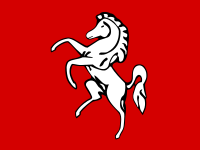
The ancient symbol of Kent is the white horse: displayed as gules a horse rampant argent, and this has in latter days formed the county flag.
The traditional badge of Kent is supposedly based on that of Hengest and Horsa, the two Jutish brothers who founded the Kingdom of Kent in 449. The names "Hengest" and "Horsa" both mean "stallion". Some say that the white horse was an emblem known in the days of the Kings of Kent, and others that it was a heraldic fancy of the sixteenth century. Whatever the origin of the emblem, it has been used for many centuries by the justices of the county and local organisations. It was also granted as arms to Kent County Council and has appeared as an element in many civic shields and emblems.
Invicta
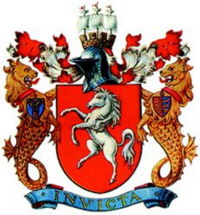
The county’s motto is Invicta (“unconquered”). Legend has it that this motto comes from the days of William the Conqueror: while William had taken London or was on his way there, he passed through Kent. The local people gathered an army and advanced against him.
One version has it that the men with branches in their hands drove William and his army to flight so that they took a different route to London. A different version of the legend is depicted on a monument at Swanscombe, where legend states this meeting took place on the Old Roman Road to London (Watling Street). The Monument (moved in the early 1960s due to the construction of the A2 Dual Carriageway) is now located in the church yard of Saint Peter and Saint Paul's Church in Swanscombe, and it states:
Near this spot by ancient tradition The Men of Kent and Kentish Men Carrying Boughs on their shoulders and swords in their hands met the invader William Duke of Normandy. They offered peace if He would grant their Ancient Rights and Liberties otherwise War and that Most Deadly. Their Request was granted and from that day the motto of Kent has been INVICTA meaning Unconquered."
Thus according to the legend, William conquered England but not Kent, which undefeated made a separate peace with him.
Arts
Kent has provided inspiration for several notable writers and artists. Canterbury's religious role gave a setting to Chaucer's Canterbury Tales, a key development in the English language. The father of novelist Charles Dickens worked at the Chatham Dockyard; in many of his books, the celebrated novelist featured the scenery of Chatham, Rochester, and the Cliffe marshes.[16]
The landscape painter J M W Turner spent part of his childhood in the town of Margate in eastern Kent, and regularly returned to visit it throughout his life. The East Kent coast inspired many of his works, including some of his most famous seascapes.[17] During the late 1930s, Nobel Prize-winning novelist William Golding worked as a teacher at Maidstone Grammar School, where he met his future wife Ann Brookfield.[18]
Things to see in Kent
| Key | |
| Cathedral/Abbey/Priory | |
| Accessible open space | |
| Amusement/Theme Park | |
| Castle | |
| Country Park | |
| English Heritage | |
| Forestry Commission | |
| Heritage railway | |
| Historic House | |
| Museum (free/not free) | |
| National Trust | |
| Zoo | |
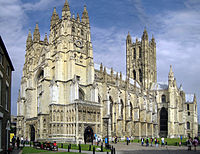
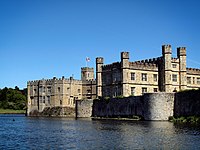
 Castles:
Castles:
- Chiddingstone Castle, Edenbridge
- Cooling Castle Barn
 Deal Castle
Deal Castle Dover Castle
Dover Castle- Hever Castle, Edenbridge - the childhood home of Anne Boleyn
- Leeds Castle, Maidstone - set on two islands on the River Len
- Lullingstone Castle, Eynsford
- Lympne Castle, Lympne
 Rochester Castle
Rochester Castle- Sissinghurst Castle, Cranbrook
- Tonbridge Castle
 Upnor Castle
Upnor Castle- Westenhanger Castle & Mediæval Barns, Hythe
- Whitstable Castle, Whitstable
 Cathedrals:
Cathedrals:
- Canterbury Cathedral
- Rochester Cathedral
References
- ↑ 1.0 1.1 Greensand Way in Kent. Kent Council. 1992. ISBN 1-873010-23-0.
- ↑ 2.0 2.1 2.2 Britain's Structure and Scenery, L Dudley Stamp, Pub September 1946, Collins New Naturalist Series.
- ↑ "Kent Downs". KentDowns.org. http://www.kentdowns.org.uk/. Retrieved 20 April 2007.
- ↑ "Geology of Kent and Boulonnais". The Geology Shop. 2000. http://www.geologyshop.co.uk/geolkb.htm. Retrieved 8 August 2009.
- ↑ Hill, Amelia (29 April 2007). "Quake causes Kent Families to flee Homes". London: The Guardian. http://observer.guardian.co.uk/uk_news/story/0,,2068090,00.html. Retrieved 28 April 2007.
- ↑ 6.0 6.1 Bowskill, Derek. Map Of The River Medway.
- ↑ Environmental Agency: River Medway
- ↑ Ashbee, Paul (2005). Kent in prehistoric times. Tempus.
- ↑ Glover, J.. Place names of Kent.
- ↑ Witney, K. P. (1982). The Kingdom of Kent.
- ↑ "Peasants' Revolt". Britannia.com. http://www.britannia.com/history/articles/peasantsrevolt.html. Retrieved 20 April 2007.
- ↑ "Sir Thomas WYATT, "The Younger"". TudorPlace.com.ar. http://www.tudorplace.com.ar/Bios/ThomasWyatt(Sir)2.htm. Retrieved 20 April 2007.
- ↑ The Historic Dockyard Chatham — where legends were created. Jarrold Publishing. 2005.
- ↑ "The Dutch In The Medway". DeRuyter.org. http://www.deruyter.org/CHATHAM_Dutch_in_the_Medway.html. Retrieved 20 April 2007.
- ↑ Oliver, Richard (1995). Ordnance Survey maps: a concise guide for historians 2nd Ed. Ordnance Survey. ISBN 1870598245.
- ↑ "Charles Dickens". InfoBritain. http://www.infobritain.co.uk/Charles_Dickens.htm. Retrieved 20 April 2007.
- ↑ "The Turner Connection". TurnerContemporary.org. http://www.turnercontemporary.org/about/?p=15. Retrieved 20 June 2007.
- ↑ "William Golding — Biography". William-Golding.co.uk. Archived from the original on March 17, 2007. http://web.archive.org/web/20070317193534/http://www.william-golding.co.uk/p_biography.html. Retrieved 20 June 2007.
Outside links
- Kent Parishes – Forum for History, Genealogy, Ancestry and local information
- Kent Wildlife Trust – Kent Wildlife Trust
- Kent Online – a Kent Messenger Group website
- Camelot Village – Kent heritage
- Kent Downs – Area of Outstanding Natural Beauty website
- CPRE Kent- Kent Branch of the Campaign to Protect Rural England
- historic-kent.co.uk – information on villages in rural Kent
- BBC – origins of Kent placenames
- Kent Coast in Pictures – photographs of the coastline of Kent.
- Kent County Cricket Club
- Official Kent Tourism Guide
- Official Heart of Kent Tourism Guide
- BBC feature on the Kent eleven-plus
- Kent-Weather – A county-wide weather forecasting website
| Counties of the United Kingdom |
|---|
|
Aberdeen • Anglesey • Angus • Antrim • Argyll • Armagh • Ayr • Banff • Bedford • Berks • Berwick • Brecknock • Buckingham • Bute • Caernarfon • Caithness • Cambridge • Cardigan • Carmarthen • Chester • Clackmannan • Cornwall • Cromarty • Cumberland • Denbigh • Derby • Devon • Dorset • Down • Dumfries • Dunbarton • Durham • East Lothian • Essex • Fermanagh • Fife • Flint • Glamorgan • Gloucester • Hants • Hereford • Hertford • Huntingdon • Inverness • Kent • Kincardine • Kinross • Kirkcudbright • Lanark • Lancaster • Leicester • Lincoln • Londonderry • Merioneth • Middlesex • Midlothian • Monmouth • Montgomery • Moray • Nairn • Norfolk • Northampton • Northumberland • Nottingham • Orkney • Oxford • Peebles • Pembroke • Perth • Radnor • Renfrew • Ross • Roxburgh • Rutland • Selkirk • Shetland • Salop • Somerset • Stafford • Stirling • Suffolk • Surrey • Sussex • Sutherland • Tyrone • Warwick • West Lothian • Westmorland • Wigtown • Wilts • Worcester • York |